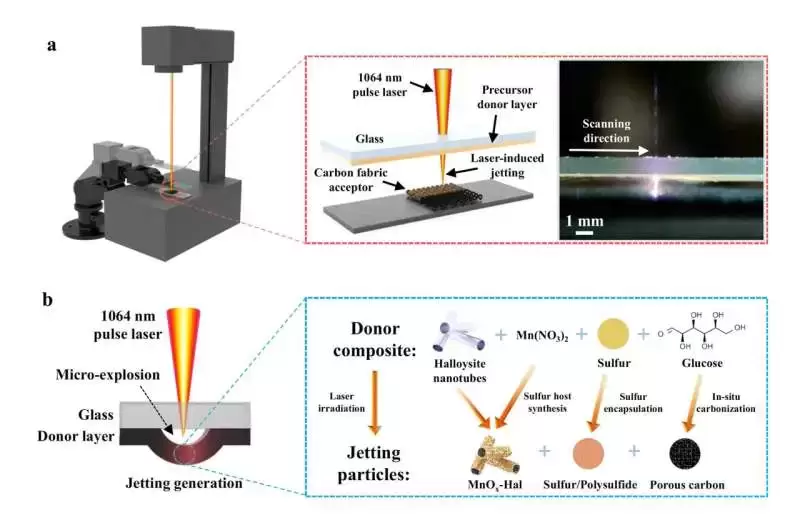 |
|
 |
|
 |
|
 |
|
 |
|
 |
|
 |
|
 |
|
 |
|
 |
|
 |
|
 |
|
 |
|
 |
|
 |
|
Cryptocurrency News Articles
From beam to battery: Single-step laser printing supercharges high-performance lithium-sulfur batteries
Apr 25, 2025 at 08:17 am
A research team has developed an innovative single-step laser printing technique to accelerate the manufacturing of lithium-sulfur batteries.

A research team has developed a single-step laser printing technique for the rapid manufacturing of lithium-sulfur batteries. This technique integrates the commonly time-consuming active materials synthesis and cathode preparation in a nanosecond-scale laser-induced conversion process, and is set to future industrial production of printable electrochemical energy storage devices.
The team was led by Prof. Mitch Li Guijun, Assistant Professor from the Division of Integrative Systems and Design at the Hong Kong University of Science and Technology (HKUST). The findings are published in the journal Nature Communications.
Lithium-sulfur batteries are promising candidates to supersede existing lithium-ion batteries due to sulfur cathodes’ high theoretical energy density. To ensure the rapid conversion of sulfur species, these cathodes are typically composed of active materials, host materials (or catalysts), and conductive materials.
However, the fabrication of host materials and preparation of sulfur cathodes often involve complicated, multistep, and labor-intensive processes that require varying temperatures and conditions, which poses challenges for efficient and low-cost industrial production.
To overcome these challenges, Prof. Li’s team developed a single-step laser printing technique for the rapid manufacturing of integrated sulfur cathodes.
During this high-throughput laser-pulse irradiation process, the precursor donor is activated, performing jetting particles that include in-situ synthesized halloysite-based hybrid nanotubes (host material), sulfur species (active material), and glucose-derived porous carbon (conductive component). The mixture is printed onto a carbon fabric acceptor, forming an integrated sulfur cathode. Notably, the laser-printed sulfur cathodes demonstrate outstanding performance in both coin and pouch lithium-sulfur cells.
Prof. Li. said:
“Traditional manufacturing processes of a cathode/anode in ion battery usually contain the synthesis of active materials (sometimes combined with host material/ catalyst), the preparation of mixture slurry, and the assembly of cathode/anode,
“These steps are usually carried out separately under different temperatures and conditions because the materials behave differently. As a result, the whole process can take tens of hours or even several days.”
Prof. Li said,
“Our newly developed laser-induced conversion technology offers a way to combine these processes into a single step at nanosecond speeds.
“The printing speed can achieve about 2 cm2/minute using only a single beam laser. A 75 × 45 mm2 sulfur cathode can be printed within 20 minutes and supply power for a small screen for several hours when assembled into a lithium-sulfur pouch cell.”
Dr. Yang Rongliang, the first author of this work and former postdoctoral fellow at HKUST, added,
“These intriguing findings generated from our study on laser-material interaction.
“The laser-induced conversion process can be characterized as an ultra-concentrated thermal phenomenon. The irradiated materials undergo a complex transient heating and cooling process, with theoretical transient temperatures reaching up to thousands of degrees Kelvin.”
The precursor materials decompose, and the decomposed particles recombine to form new materials.
“This ultra-concentrated thermal process not only enables the formation and combination of materials with different natures, but also drives the concomitant micro-explosions that facilitate the jetting and transferring of forming particles.”
Disclaimer:info@kdj.com
The information provided is not trading advice. kdj.com does not assume any responsibility for any investments made based on the information provided in this article. Cryptocurrencies are highly volatile and it is highly recommended that you invest with caution after thorough research!
If you believe that the content used on this website infringes your copyright, please contact us immediately (info@kdj.com) and we will delete it promptly.
-

- Bitcoin (BTC) price holds above $90,000 despite correction, surging institutional interest drives record ETF inflows
- Apr 25, 2025 at 04:00 pm
- Bitcoin continues to demonstrate significant resilience, maintaining levels above the crucial $93,000 mark after weathering a notable correction earlier this year.
-

-

-

-

-

-

-

- Raphael Coin (RAPH) Introduces Tokenized Version of Recto: Study for the Battle of the Milvian Bridge
- Apr 25, 2025 at 03:45 pm
- Raphael Coin (RAPH), a blockchain initiative focused on democratizing fine art investment, has introduced the tokenized version of Recto: Study for the Battle of the Milvian Bridge
-

- What if the Next Major Innovation in Blockchain Technology Wasn't Just Another Coin or Altcoin, But a Comprehensive Solution to the Real-Life Challenges Businesses and Professionals Face?
- Apr 25, 2025 at 03:40 pm
- While many blockchain projects have attempted to address issues like scalability, transaction fees, and security, few have truly tackled the core inefficiencies




























































